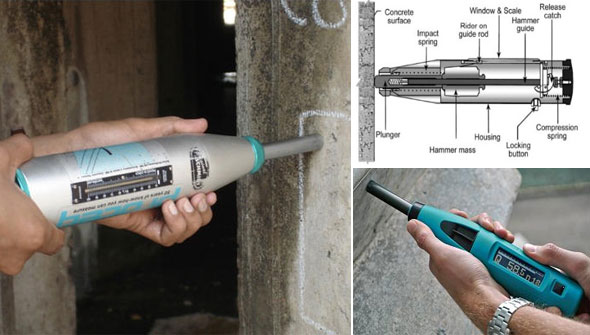Concrete, a fundamental material in construction, owes its durability and strength to meticulous quality control measures. One such essential test employed in assessing the compressive strength of concrete is the Rebound Hammer Test. In this article, we explore the principles behind the test, its methodology, its interpretation of results, and its significance in ensuring the structural integrity of concrete.
Principles of the Rebound Hammer Test:
The Rebound Hammer Test, also known as the Schmidt Hammer Test, operates on the principle of rebound. It measures the hardness of the concrete surface by rebounding a mass (hammer) off the surface. The rebound distance is then correlated to the compressive strength of the concrete.
Components of the Rebound Hammer:
- Hammer: The rebound hammer consists of a spring-loaded mass that is released to strike the concrete surface.
- Anvil: The anvil provides support for the concrete surface during testing, ensuring a consistent and stable testing environment.
- Pointer and Scale: These components are used to measure and record the rebound distance for subsequent analysis.
Methodology of the Rebound Hammer Test:
- Surface Preparation: The concrete surface must be clean, dry, and free from loose particles. Any existing coatings or contaminants can impact the accuracy of the test.
- Testing Points: The test is conducted at various locations on the concrete surface, ensuring representative results. Testing points should cover different areas of the structure.
- Number of Strokes: Multiple strokes are performed at each testing point, and an average rebound value is recorded to minimize variations.
Interpretation of Results:
- Rebound Number: The rebound number, also known as the rebound value, is the ratio of the height of the rebound to the height of the initial drop. This value then correlated with the compressive strength of concrete using conversion charts provided by the instrument manufacturer.
- Strength Estimation: While the rebound number provides an estimate of the compressive strength, it is crucial to note that it represents the surface hardness and may not reflect the overall strength of the concrete. The test is most accurate when applied to concrete with a uniform composition.
Factors Affecting Rebound Hammer Test Results:
- Surface Conditions: A rough or uneven surface can affect the rebound of the hammer.
- Moisture Content: Excessive moisture in the concrete can impact rebound values.
- Aggregate Size: Large aggregates near the surface may influence test results.
- Curing Conditions: Variations in curing conditions can affect the concrete’s strength and, consequently, the rebound values.
Significance in Quality Control:
- On-Site Assessment: The Rebound Hammer Test is a valuable tool for on-site assessment of concrete strength, allowing quick and non-destructive evaluations.
- Quality Assurance: Contractors and engineers use the test to ensure that the delivered concrete meets specified strength requirements.
- Monitoring Aging Structures: The test also use in assessing the condition of existing structures over time, helping to identify potential areas of concern and plan for maintenance or rehabilitation.
Limitations and Considerations:
- Surface Sensitivity: The test primarily assesses the surface hardness, and variations in surface conditions can impact accuracy.
- Localized Variability: The concrete composition may vary within a structure, and the test may not capture these localized differences.
- Calibration: Regular calibration of the rebound hammer is essential to maintain accuracy.
Conclusion:
The Rebound Hammer Test stands as a reliable and widely used method for assessing the compressive strength of concrete in various construction scenarios. As a non-destructive testing technique, it provides a valuable tool for quality control, ensuring that concrete structures meet the required standards for durability and longevity. While it has its limitations, when used judiciously and in conjunction with other testing methods, the Rebound Hammer Test is an indispensable asset in the hands of engineers and construction professionals, contributing to the longevity and safety of concrete structures.

